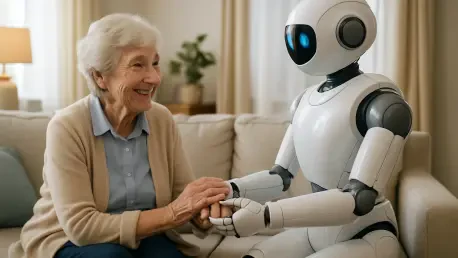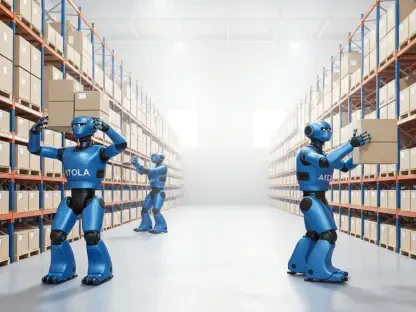Imagine a world where the silent burdens of caregivers—those unsung heroes tending to loved ones with chronic illnesses or disabilities—are lightened by a compassionate, ever-present companion. With millions of informal caregivers facing emotional exhaustion and isolation today, the demand for innovative support solutions has never been more pressing, and social robotics, an emerging field blending technology with human interaction, offers a glimmer of hope. This review dives into the transformative potential of social robots, focusing on their role in alleviating the psychological pressures faced by caregivers through empathetic engagement and companionship.
The landscape of caregiving is often marked by a profound lack of emotional outlets. Many caregivers, juggling personal sacrifices with relentless responsibilities, find themselves with little time or space to process their own feelings. Social robots, such as the humanoid robot Pepper developed by SoftBank Robotics, are stepping into this gap, providing a non-judgmental space for self-expression. This analysis aims to unpack the capabilities, real-world impact, and future possibilities of these robotic companions in supporting those who give so much of themselves to others.
Exploring the Core Features of Social Robots
Emotional Intelligence and Interaction
At the heart of social robotics lies the ability to simulate emotional intelligence, a feature that sets these machines apart from traditional assistive tools. Robots like Pepper are equipped with algorithms to detect human emotions through facial expressions, tone of voice, and body language, enabling them to respond with appropriate empathy. For caregivers, this means having a companion that can acknowledge their frustration or sadness, offering comforting words or simply listening without judgment, which can significantly reduce feelings of loneliness.
The significance of such interactions cannot be overstated in a context where emotional support is often scarce. By creating a safe space for caregivers to vent or reflect, these robots address a critical gap in mental health resources. While the responses may lack the depth of human understanding, the consistency and availability of a robot’s presence provide a unique form of relief, especially during moments of acute stress or isolation.
Conversational Adaptability and Learning
Another standout feature of social robots is their capacity for conversation, enhanced by adaptive learning technologies. Through machine learning, these robots refine their speech patterns and responses based on past interactions, tailoring their dialogue to the user’s preferences and emotional state. This adaptability ensures that conversations feel more natural over time, fostering a sense of connection for caregivers who might otherwise lack social engagement.
The technical backbone of this functionality includes advanced speech recognition and natural language processing systems. These allow robots to not only understand spoken words but also interpret context and intent, making interactions more meaningful. For caregivers, sustained engagement with a robot that remembers past conversations and adjusts accordingly can translate into improved emotional well-being, as it mimics the familiarity of a trusted confidant.
Performance in Real-World Caregiving Scenarios
Practical Applications Across Diverse Settings
The deployment of social robots in caregiving environments has revealed promising outcomes across various contexts. In households where caregivers support children with disabilities or elderly individuals with dementia, robots have proven to be invaluable allies. They offer companionship during long, solitary hours, engaging users in light conversation or even reminding them to take breaks, thereby easing the constant pressure of caregiving duties.
Specific interventions, such as those studied by researchers at a leading university, highlight the tangible benefits of these robots. Caregivers reported feeling less overwhelmed after regular interactions with a robot, as it provided a consistent outlet for emotional expression. Such real-world applications underscore the potential of social robotics to address niche challenges, particularly for those in remote or underserved areas with limited access to human support networks.
Measurable Impact on Emotional Health
Delving deeper into performance metrics, the emotional health benefits for caregivers are striking. Studies show that consistent interaction with social robots leads to reduced stress levels and a more positive outlook on the caregiving role. Participants often describe a newfound ability to reflect on their experiences without fear of burdening others, a factor that contributes to better mood regulation and decreased feelings of isolation.
Beyond individual benefits, the ripple effect on caregiving dynamics is noteworthy. When caregivers feel emotionally supported, their capacity to provide care improves, creating a more stable environment for those they assist. This dual impact—on both caregiver and care recipient—positions social robots as a holistic tool in enhancing overall household well-being, even as the technology continues to evolve.
Challenges Hindering Widespread Adoption
Technical and Ethical Barriers
Despite their potential, social robots face significant hurdles in becoming mainstream caregiving tools. On the technical front, current limitations in emotional recognition mean that robots sometimes misinterpret complex human feelings, leading to responses that feel out of touch. Additionally, the high cost of development and maintenance poses an accessibility challenge, restricting these technologies to a smaller, often more affluent user base.
Ethically, concerns arise about the risk of replacing genuine human interaction with robotic substitutes. Critics argue that over-reliance on robots could further isolate caregivers from real social connections, potentially deepening emotional voids rather than filling them. Balancing the role of robots as supplements rather than replacements for human contact remains a critical issue for developers and policymakers alike.
Regulatory and Trust Issues
Regulatory frameworks for social robotics are still in their infancy, creating uncertainty around safety standards and data privacy. Caregivers may hesitate to share personal emotions with a device if there are doubts about how their information is stored or used. Building trust in these systems requires transparent guidelines and robust security measures to ensure user confidence.
Moreover, cultural and personal attitudes toward technology influence adoption rates. Some caregivers view robots with skepticism, perceiving them as impersonal or intrusive. Overcoming these perceptual barriers through education and gradual exposure is essential for integrating social robots into everyday caregiving routines, a process that demands patience and strategic outreach.
Looking Ahead: The Future of Social Robotics
Innovations on the Horizon
The trajectory of social robotics points toward exciting advancements, particularly in personalized emotional support. From 2025 onward, developers are expected to refine algorithms for even more nuanced emotion detection, enabling robots to respond with greater accuracy and depth. Integration with other smart home technologies could also create seamless caregiving ecosystems, where robots coordinate with devices to provide comprehensive support.
Emerging research suggests potential breakthroughs in customizing robot personalities to match user preferences, further enhancing the sense of companionship. Such innovations could transform robots into indispensable partners for caregivers, offering tailored interactions that evolve alongside individual needs and circumstances over the coming years.
Societal and Long-Term Implications
On a broader scale, the integration of social robots into caregiving could reshape societal approaches to mental health support. As these technologies become more accessible, they may redefine how emotional distress is managed, particularly for isolated populations. The long-term vision includes robots as standard fixtures in healthcare systems, complementing human efforts rather than competing with them.
The societal shift toward accepting robotic companions also raises questions about future caregiving models. If robots can alleviate some emotional burdens, resources might be redirected to other pressing areas, such as training for caregivers or expanding community support programs. This potential reallocation could herald a new era of balanced, technology-augmented care systems.
Reflecting on the Journey and Next Steps
Looking back, the exploration of social robots as caregivers reveals a technology brimming with promise, despite its early-stage challenges. Their ability to provide emotional support and companionship to overburdened caregivers marks a significant step forward in addressing an often-ignored aspect of healthcare. The tangible improvements in mood and stress levels among users during interventions paint a hopeful picture of what is possible.
Moving forward, the focus should shift to addressing technical shortcomings and ethical concerns through collaborative efforts between developers, regulators, and caregivers themselves. Investment in making these robots more affordable and culturally adaptable will be crucial for broader impact. As society stands on the cusp of a caregiving revolution, prioritizing research and dialogue around trust-building and integration strategies will ensure that social robotics fulfills its potential as a compassionate ally in the years ahead.









